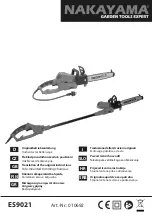
--- 17 ---
7-3. Relative Standards
Standards, regulations and guidelines for the safe use of laser equipment
[USA]
FDA CDRH 21 CFR
[AUS/NZL] AS/NZS 2211.1:2001
[EUROPE] EN 60825-1: 2001-11
7-4. Laser Marker (Only Model C 10FSH)
The Model C 10FSH is equipped with the laser marker that complies with the Class II requirements of the
standard specified in "7-3. Relative Standards". The Class II laser is defined as follows:
The laser power is low and it is safe by the protective measures such as blinking. However, it is dangerous if
the operator's eyes are exposed directly to the laser for a protracted period.
The operator can use the laser equipment without particular training and instruction.
The amount of light exposure (output) is 1 mW or less at the position where the operator can be exposed to
the laser radiation during operation. (This is in the case of the U.S.A. The measuring methods and the output
values are different depending on the standards.)
The saw blade unit prevents access of the operator's eye to the laser emitting aperture less than 65 mm.
In addition, the amount of light exposure (output) is 1 mW or less (about 0.4 mW) at this position. Thus the Model
C 10FSH satisfies the Class II requirements adequately. There is no ill effect on the operator's body if looking at
the laser line on the workpiece during operation.
[CAUTION] (1) Be sure to disconnect the power cord plug from the receptacle before removing the laser
marker for repair. If it is unavoidable to check the operation of the removed laser marker
with the power turned on, face the laser emitting aperture to the ground to show the laser
line on the ground.
(2) Laser radiation when open. DO NOT STARE INTO BEAM OR VIEW DIRECTLY WITH
OPTICAL INSTRUMENTS.
The lifespan of the laser marker in the Model C 10FSH is about 5,000 hours. (About five years: 5 hours of use/day
x 200 days/year)
















































